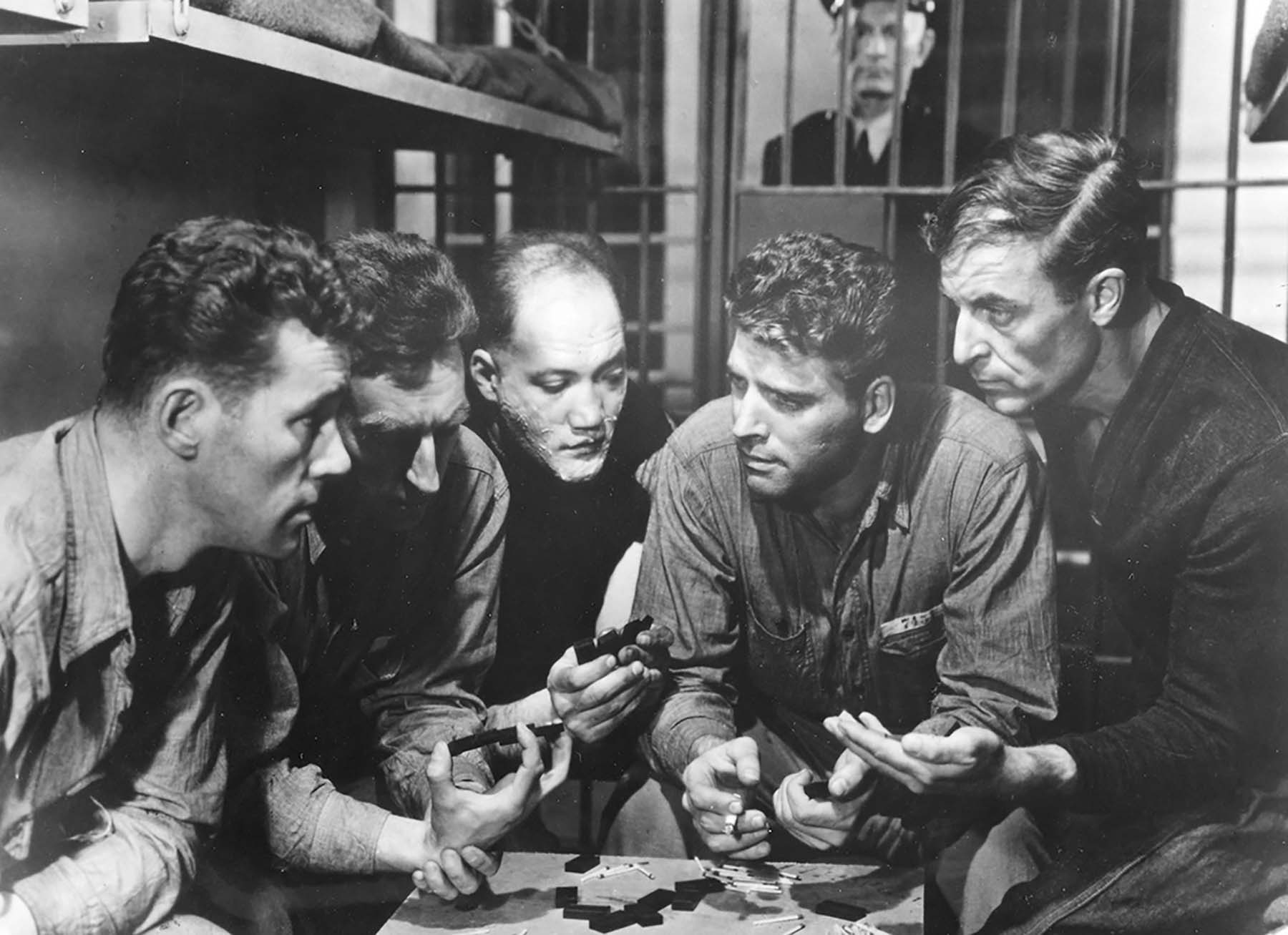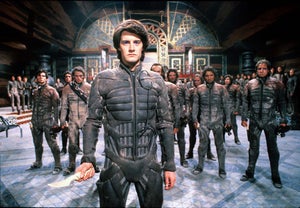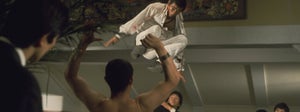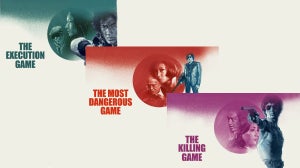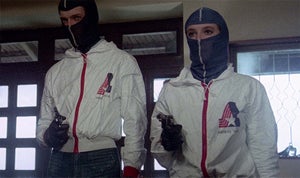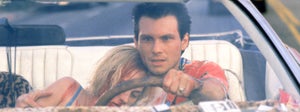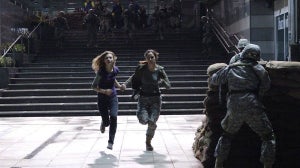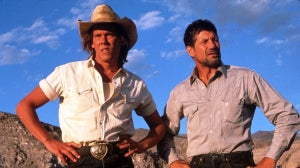
Film noir, the genre that isn't really a genre, is often identified by critics as a product of a very specific time and place: namely, America in the aftermath of World War II. As filmmaker Paul Schrader wrote in his seminal essay Notes on Film Noir: “The disillusionment many soldiers, small businessmen, and housewives/factory employees felt in returning to a peacetime economy was directly mirrored in the sordidness of the urban crime film...the war continues, but now the antagonism turns with a new viciousness towards the American society itself.”
All of this is fairly inarguable; given the amount of noir films which involve characters recently returned from the war, the theme is commonly played out more as text than subtext. And yet, there is another seismic period in American history which is an equally inextricable aspect of film noir; the rot in the wound, as it were.
I refer to the communist witch-hunts of the 1940's and 50's; which in turn led directly to the Hollywood blacklist, or what playwright Lillian Hellman scathingly referred to as “Scoundrel Time.” As a result of the House Un-American Activities Committee (HUAC) congressional hearings, many noir filmmakers with leftist sympathies or associations were driven out of work or even out of the country due to their refusal to inform on friends and colleagues, while others eventually named names and were allowed to continue working in Hollywood.
One of the more notable figures amongst the first group was director Jules Dassin, and on the occasion of Arrow releasing two of his classic noirs – Brute Force and The Naked City – in Tales from the Urban Jungle on Blu-ray, we thought we'd take a look back at exactly how the Hollywood blacklist impacted his work and that of several of his filmmaking peers.
1948's The Naked City may be the most influential film Dassin ever made; its semi-documentary procedural approach was groundbreaking at the time, and the effect of it has lingered across the decades, from gritty neo-noirs such as The French Connection (1971) up to such acclaimed modern television shows as The Wire (2002-08). Nevertheless, in its savagely paranoid anticipation of the blacklist that was soon to come, Brute Force (1947) might be an even more interesting work. Set in an American prison whose administrators favour brutal punishment over rehabilitation, the film is a microcosmic examination of a society where everyone is considered guilty, and live in terror of attracting further retribution. In the climate of fear fostered by the prison's sadistic warden, the only way for the inmates to protect themselves from further persecution is to rat out their fellow prisoners. And while the film makes no bones about the fact that informing on one's colleagues is a cowardly, despicable act, neither does it harbour any sentimental illusions about what the cost of resistance might be. In the world of Brute Force, no one gets out alive, and all that you get to take with you when you go is your dignity – which might be the very thing that got you killed in the first place.
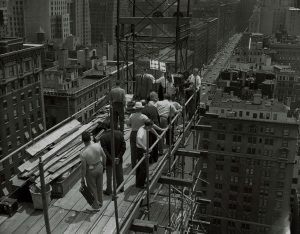
The Naked City subsequently won two Oscars, and yet within two years of that triumph Dassin was unemployable in Hollywood. Having learned that the director was about to be named as a former member of the Communist Party USA (Dassin had quit the party in 1939), 20th Century Fox studio head Daryl F. Zanuck assigned him to direct Night and the City, a noir thriller set in the seedy milieu of London's Soho district. Fleeing the US might have bought Dassin a little time, but he knew he was a marked man nonetheless, and the festering paranoia that ran through Brute Force subsequently reached its apotheosis here, in another story of a little guy trying to outwit the system and being crushed by it in the attempt. As Night in the City's hunted protagonist Harry Fabian despairingly admits, “All my life I've been running”, but when everybody is out to get you, there's only so far anyone can run. By the end of the film, Fabian learns that to his cost, but it was a lesson Dassin already well understood. He would never make another film in America.
The man who had identified Dassin to HUAC was fellow director Edward Dmytryk, one of the original “Hollywood Ten”. The Hollywood Ten were a group of writers and directors who had been called before the committee in 1947, but publicly refused to testify and were given jail terms as a result. Like Dassin, Dmytryk then fled to England to work, but eventually his passport expired and he was forced to return to the US, where he was immediately imprisoned. This was enough to convince him to turn on his former party colleagues, and in 1951 he once again appeared before HUAC. This time he offered up several names, including those of Dassin and seven other film directors.
Much like Jules Dassin, Edward Dmytryk had established himself pre-blacklist as a prestige filmmaker, working his way up through the Hollywood ranks to win a Best Director Oscar nomination for his 1947 noir Crossfire, the story of an anti-Semitic murder and the ensuing manhunt. But while that film is emblematic of the progressive, socially-conscious strain of noir (like many of the other noir works made by the blacklistees pre-HUAC), the low-budget film the director made immediately after his release from jail is perhaps more personally revealing and even more interesting.
The Sniper (1951) is firstly notable for its structural design; the opening half of the film is told entirely from the point-of-view of a misogynistic psychopath (a bold choice for the time, which feels very reminiscent of the New Hollywood approach of a later film like Martin Scorsese's Taxi Driver (1976)). By putting us in the killer's shoes, Dmytryk allows us to see first-hand exactly how American society continually fails him. As one character puts it, “He's loose because of us, a killer because of us.” Even when the narrative opens up in the film's second half to include the police hunt for the sniper, the audience's empathy remains firmly with the killer. While we certainly want to see him caught, the cops investigating the murders are portrayed as brutal and uncomprehending; they would rather solve the case by simply gunning their quarry down, thus perpetuating the cycle of societal violence Dmytryk so carefully delineates.

In addition, it's difficult not to also view The Sniper as something of a confessional work by the director. In its scathing account of a lost soul abandoned by his country, a desperate man who wanted to do the right thing but instead finds himself threatened and hounded by authoritarian forces that wish only to destroy him, do we perhaps see a ghost portrait of Dmytryk himself? The last shot of the film shows the captured killer sitting alone, a single tear trickling down his cheek. Is this the director's wordless statement about what America had done to him?
Director Joseph Losey would also find himself blacklisted in 1951, having already established his progressive credentials in earlier noir films such as The Lawless (1950) and The Prowler (1951). Much like Crossfire, the former movie is another account of the barely-disguised bigotry seething at America's heart (its climactic scenes of a racist mob storming a newspaper's offices feel uncomfortably prescient in the wake of the 2021 assault on the US Capitol Building), and while it is perhaps less of a conventional noir (critic Thom Anderson defined The Lawless as a film gris: a type of noir that focuses more on society's failings than those of individual characters), the film Losey made next is unquestionably a pitch-black work of the genre.
The Prowler is a knowing riff on Billy Wilder's classic Double Indemnity (1944); however, unlike that film, the female protagonist is no manipulative femme fatale but an entirely innocent woman, and the central murder plot is instead the work of her cop lover, a money-grubbing creep desperate to try and get rich quick (like Dmytryk in The Sniper, Losey is unafraid to point an accusatory finger at the corruption of the US police). By the film's climax, the lowlife cop is reduced to fruitlessly trying to scramble up a hill of dirt in an attempt to escape the pursuing authorities; Losey's bitterly apt visual metaphor for social advancement in America.
The Prowler was covertly scripted (using a different writer as a front) by the blacklisted screenwriter Dalton Trumbo, another member of the original Hollywood Ten. Trumbo's involvement in the film clearly showed where Losey's political sympathies lay, and unsurprisingly, the director had already come under HUAC suspicion himself by the time he went into production on his next film: the underrated remake of Fritz Lang's classic silent film M.
Looked at now, M represents an unmistakeable statement on the communist witch-hunts of the period. As in Jules Dassin's Night and the City, Losey's film concerns a man with no choice but to run for his life, and yet with absolutely nowhere to run to. And like Dmytryk's The Sniper, the protagonist may be a psychotic murderer, but the mob of corrupt informers and merciless vigilantes that he finds himself pursued by are scarcely any more admirable (in a pointed moment, the director at least allows the protagonist the climactic satisfaction of killing his treacherous lawyer before the police arrive to take him away). These films leave the viewer in no doubt that something had gone very rotten in America's republic. M was Losey's parting shot to the country of his birth; like Dassin, he would subsequently flee America and spend the rest of his directing career working in Europe.
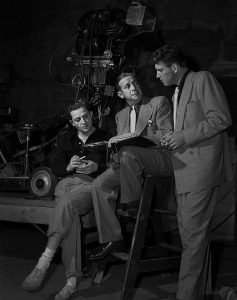
Persecuted and driven abroad they might have been, but at least Dassin and Losey managed to both defy HUAC and build successful careers elsewhere; writer/director Abraham Polonsky would not be quite so fortunate. In 1951, he would be called before the committee and deemed a “very dangerous citizen” for his noncompliance, but only four years earlier, Polonsky had been another pre-blacklist Hollywood success story; Oscar-nominated for his screenplay for Body and Soul, Robert Rossen's noirish look at the sleazy world of professional boxing. While the film was a big hit at the time, most of Body and Soul's main creative contributors would soon be brought down by the witch-hunts; aside from Polonsky, director Rossen was blacklisted for two years before eventually capitulating and naming 57 names, and in the most egregious injustice of all, the film's star John Garfield succumbed to a fatal heart attack after seeing his acting career destroyed, due to his continued refusal to inform on his friends. “[Garfield] defended his street boy's honour, and they killed him for it,” Polonsky commented.
But in the immediate wake of Body and Soul, Polonsky was a hot property, and so in 1948 struck a deal to make his directorial debut, Force of Evil. A lifelong Marxist, the writer's beliefs had already been evident in his script for Rossen's film, wherein the sport of boxing became a symbol of capitalistic greed and violence. This time, Polonsky took the numbers racket as his central metaphor. Force of Evil would be another angry indictment of the American way of life; as Martin Scorsese said of the film, “It's not just the individual who is corrupted, but the entire system.” Although it was not financially successful at the time, Force of Evil has since been acclaimed as one of the great film noirs, its bleak poeticism setting it apart from many of its more prosaic crime movie peers.
But tragically, in Polonsky's case the blacklist proved all too effective, and he would not direct again for over twenty years. Although the writer continued to work for hire under various assumed names, he habitually refused to divulge those credits, and so very little is known about the screenwriting he did during that period. One film Polonsky is known to have scripted, however, is Robert Wise's Odds Against Tomorrow (1959).
Yet another noir allegory about racism, Odds shares one of its leading men with Crossfire – Robert Ryan, playing yet another scumbag bigot – but eschews the well-intentioned liberalism of Dmytryk's film in favour of a far more confrontational approach. In the course of the narrative, Ryan's racist crook is forced to partner up with a black nightclub entertainer (played by Harry Belafonte) in order to carry out an bank heist, with predictably ill-fated results. His experiences at the hands of the US Government had taught Polonsky that there could be no longer be any happy endings. So, by the time Odds Against Tomorrow arrives at its (literally) incendiary climax, its two antagonists lay burned to a crisp, each now entirely indistinguishable from the other. A sign nearby reads, “Stop, Dead End.”
In many respects, film noir was indeed something of a dead end; as the cycle entered its late period in the 1950's, noir movies became increasingly bleak and pessimistic (what Paul Schrader identifies as the “period of psychotic action and suicidal impulse”), and Hollywood's dream factory has never been entirely comfortable with such adjectives. By the end of the 50's, film noir was already starting to retreat into the shadows.

